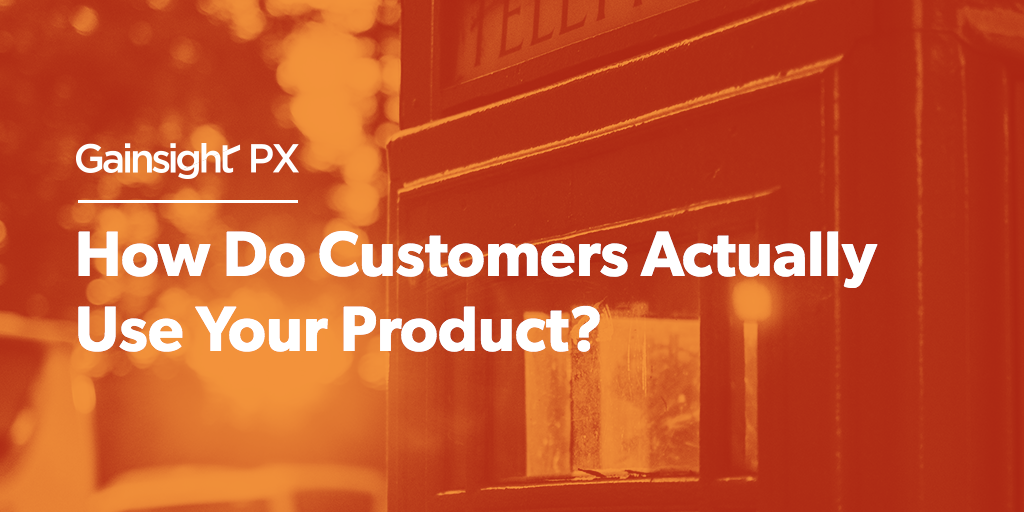This may seem like a really odd question on the surface.
But, if you’re working at a software company today, or ever have, you know it’s really not that strange to ask, “How are our customers actually using our product?” For most of the history of software, we simply did not know how to answer this. Short of watching and recording a user interacting with it, there was no definitive way to track this. And even that method didn’t reveal the many, nuanced ways each individual customer was interacting with the program.
Not surprisingly, this led to a lot of money being poured into the development of products or features that ended up not providing value. Or worse, they weren’t used at all. It wasn’t because Product teams didn’t care, they just didn’t know—and there weren’t great ways to find out.
SaaS changed many things but perhaps the biggest is this: we can now track exactly what customers are doing in our products. Since today we host our solutions (or pay AWS or Azure to host them for us), as opposed to the old world of on-premise, behind-the-customer-firewall products, we can literally see every single click that happens in our product. That changes everything for Product teams and Customer Success teams—and the entire company.
Collecting Product Data is Easier Than Ever
Every single organization in a company is more data-driven today than they ever have been. That’s largely due to technology. Exhibit 1: Sales and Marketing. The advent and proliferation of CRM and Marketing Automation solutions has made the top of the funnel a data-rich environment. Here are just a few examples:
- Change the location of a button on your website and know two hours later if it increased conversions.
- Make a new piece of content available and immediately start counting the downloads.
- Move a deal to the next pipeline stage and instantly see a new “likelihood of closing this quarter” percentage.
When I first took the VP of Customer Success job at Marketo I remember begging our Ops team for a simple weekly report telling me which customers hadn’t logged in over the past 30 days. Now, I can not only tell who is logging in and how often, but how much time they spent in the system, which features they used, and what path they followed to complete a task inside my product. This plethora of data has had an enormous impact on our ability to monitor customer health. It also gives us the ability to evaluate the actual value of each feature within our product, which is vital for any successful Product team.
Turn Your Product Data into Actionable Insights
In addition to providing insights into the value of our features and our product, we can also begin to understand how customers use our products. This kind of information becomes invaluable in our quest to reduce time-to-value.
One great example is the user path. If we know that every new user does A then B then D in our product while we assumed it would be A, B, C, we can make data-driven decisions on what to change (i.e. product, onboarding, training).
In that situation, perhaps we decide A, B, D is more efficient and we just eliminate C altogether. The point is that we can discuss these things intelligently now with lots of data from which to draw a conclusion.

With Funnels in Gainsight PX, you can track each step and identify where users fall off from completing critical tasks/conversions within your product.
Other product analytics that we are now able to derive from data include:
Cohort Retention Analysis
You have a limited amount of time to guide users to realize the value of your product. What features are driving retention? Knowing how well your product retains its users is key to long term growth.
Journey Analysis
How did this specific user get to this specific feature? Where did they go next? Every user is unique in the way they learn and adopt your product. Journey analysis helps you visualize this activity and surface unexpected behaviors.
Funnels Analysis
Mentioned in the example above, Funnels Analysis help identify where users fall off from your product, whether it’s completing an order, building a report, or other common activities.
Feature Performance
Are people using your features? And more importantly, did it influence revenue? Analyzing Feature Performance in your product analytics platform can help you discover the features that are impacting revenue and customer lifetime value. The more powerful the tool, the more you can spot trends across segments and slice and dice by user and account level attributes.
“6 Important Product Management Metrics and How to Improve Them.”
The data you collect empowers your business. Learn what metrics to watch and how to improve them in this blog post.
Operationalizing Your Product Insights
Tracking how a user moves through your product is table stakes for a lot of today’s product analytics tools—it’s what you do with that data that’s important. It’s important to note that when it comes to product analytics programs, some may cover just one piece of the puzzle. You need to collect the data to answer the question “How does my user move through my product?” but, you also need the means to operationalize those insights and in influence user activity. In this case, driving adoption can come in the form of personalized in-app engagements or guides.
Technology brings great news to this discussion because there are many products today that can help give insight into customer product usage. In addition, the products that provide the most robust usage analytics (like Gainsight PX) also allow you to weave user guidance into your product. So, your product becomes self-training in that it can show a user the best path through your product to accomplish the outcome for which they are striving.

With Gainsight PX, you can add Tooltip, Dialog, or Hotspot steps when you build an In-App ‘Guide’ Engagement.
This is truly game-changing because the previous ways to accomplish this were very expensive and much slower—training programs, onboarding processes, CSM one-on-ones. In an era of machine learning, this is machine teaching.
Much like our friends in Sales and Marketing who have become data-driven, even data-obsessed, those of us on Product teams or in Customer Success now have that same opportunity and we need to take it.
“How to Build a Data-Driven Product Your Customers Love”
Our execs will share their take on why product experience is a business imperative.See Gainsight PX in action and learn the story behind it in this webinar.
Let’s Get Started
Every possible way we can shave a day off time-to-value, every time we do a release and nail the UX, or every time we have to trade-off a new feature for an improvement in an existing one, we have data and intelligence to draw on in order to make the best decision.
Everything we do in business requires a trade-off. The winner is often the company that makes the smartest trade-offs and that can be done only with more information and more intelligence. As Jim Barksdale, CEO at Netscape, once said, “If we have data, let’s look at the data. If all we have are opinions, we’re going with mine.”
Gainsight PX helps Product and CS teams collect and operationalize data to build products customers love. Sign up for a personalized demo today to see for yourself.

